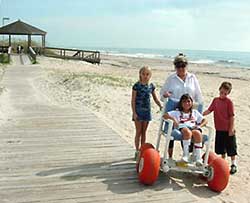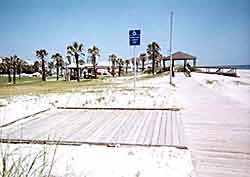|
Fernandina Beach, Florida
A resort community improves access
to city programs and services for residents and vacationers.
 Fernandina Beach, Florida, a resort community of 8,800 residents on Amelia Island between the Atlantic Ocean and the Amelia River, is Florida's second oldest city and the State's first resort area. With its 50-block downtown historic district, golf courses, parks and nature areas, beaches, and a resident shrimping fleet, the community welcomes visitors and vacationers from all corners of the country. And recently, Fernandina Beach became an even more welcoming place for people with disabilities. Fernandina Beach, Florida, a resort community of 8,800 residents on Amelia Island between the Atlantic Ocean and the Amelia River, is Florida's second oldest city and the State's first resort area. With its 50-block downtown historic district, golf courses, parks and nature areas, beaches, and a resident shrimping fleet, the community welcomes visitors and vacationers from all corners of the country. And recently, Fernandina Beach became an even more welcoming place for people with disabilities.
In response to a complaint filed by two residents with disabilities, the Department began working with Fernandina Beach officials to identify various barriers to access throughout the city. The city looked at everything, from its beaches, marinas and parks, to all its buildings, offices, and programs, to its streets and sidewalks. From the beginning, the city expressed an interest in not simply reducing the number of barriers that existed, but eliminating them. The city of Fernandina Beach made a decision – and a commitment – to go above and beyond the minimum ADA requirements and to make the city as useable and accessible as possible for everyone.
 To do this, city officials and residents worked together to find new approaches to accessibility, an experience they found both gratifying and exciting. According to DeeAnn Barton, a resident and advocate, “With community effort, everybody wins. The city is very open to citizen input. The city and the community are trying to do everything from a really positive standpoint. We are building a better community through the elimination of barriers.” And that positive collaboration has made a difference in the quality of life for everyone in Fernandina Beach, whether they live there or are just visiting for a while. To do this, city officials and residents worked together to find new approaches to accessibility, an experience they found both gratifying and exciting. According to DeeAnn Barton, a resident and advocate, “With community effort, everybody wins. The city is very open to citizen input. The city and the community are trying to do everything from a really positive standpoint. We are building a better community through the elimination of barriers.” And that positive collaboration has made a difference in the quality of life for everyone in Fernandina Beach, whether they live there or are just visiting for a while.
 The city is working to make all its playgrounds accessible. Each city playground will have new accessible equipment, accessible playground surfaces, and accessible paths to the playground equipment. Cheri Fisher is thrilled with the changes. She no longer has to lift her daughter onto the play equipment and she happily can watch "Brittany and her buddy go down the slide together. What's really good is that Brittany now can play longer because she's not as tired from trudging to the playground. She also can play on pretty much all the equipment and play together with her friends; she's not being excluded now.” Ten-year-old Brittany, who uses crutches and sometimes a wheelchair to get around, agrees. “I like the rope things that go round and round and I like the slide with the bumps and I liked the three of us sliding together!” In addition to creating accessible playgrounds, the city installed an accessible route to the picnic pavilions in each of its city parks and accessible picnic tables in every pavilion. The city is working to make all its playgrounds accessible. Each city playground will have new accessible equipment, accessible playground surfaces, and accessible paths to the playground equipment. Cheri Fisher is thrilled with the changes. She no longer has to lift her daughter onto the play equipment and she happily can watch "Brittany and her buddy go down the slide together. What's really good is that Brittany now can play longer because she's not as tired from trudging to the playground. She also can play on pretty much all the equipment and play together with her friends; she's not being excluded now.” Ten-year-old Brittany, who uses crutches and sometimes a wheelchair to get around, agrees. “I like the rope things that go round and round and I like the slide with the bumps and I liked the three of us sliding together!” In addition to creating accessible playgrounds, the city installed an accessible route to the picnic pavilions in each of its city parks and accessible picnic tables in every pavilion.
In Fernandina Beach, the marina and dock are vital community assets, part of what makes the waterfront so attractive to residents and visitors alike. The city created accessible routes from the marina's administrative offices and public restrooms to its shops and restaurants, and from the shops and restaurants to the dock itself. And now, because the dock is accessible to people who use wheelchairs, even at low tide, other opportunities have sprung up in Fernandina Beach. Steve Hair, a local boat captain who previously had made his charter boat, "Ye Ole Pirate," wheelchair accessible, asked the city if he could keep his boat at the dock. Pleased to have an accessible boat available to residents and visitors with disabilities, the City Commission responded generously, offering reduced rates on docking fees and gasoline costs. “Ye Old Pirate” is now docked in the slip closest to the accessible dock ramp, allowing people with disabilities to get to and onto the charter boat independently. Wheelchair user Jack Jones, vacationing in Fernandina Beach recently, enthused that this was the first time he had ever been able to get onto a boat totally on his own. On previous fishing trips, he had to be lifted out of his power wheelchair and carried onto the boat, leaving his wheelchair ashore. The trip down the ramp to the dock and onto “Ye Old Pirate” was “easy and smooth. It felt good.”
 The city constructed a beach walkover at the Main Beach, and constructed an accessible viewing area connected to the accessible beach path, allowing as many as eight people using wheelchairs to sit together on the beach and enjoy an unobstructed view of the surf. The city plans to construct two additional walkovers at opposite ends of the city at the North Park and Seaside Park Beaches to provide wheelchair users access to the beach nearest them. The city also purchased two beach wheelchairs for those wishing to join family and friends near the water on the sandy beach. It has plans to buy more. The city constructed a beach walkover at the Main Beach, and constructed an accessible viewing area connected to the accessible beach path, allowing as many as eight people using wheelchairs to sit together on the beach and enjoy an unobstructed view of the surf. The city plans to construct two additional walkovers at opposite ends of the city at the North Park and Seaside Park Beaches to provide wheelchair users access to the beach nearest them. The city also purchased two beach wheelchairs for those wishing to join family and friends near the water on the sandy beach. It has plans to buy more.
At the Peck Center, a 104-year old former school converted to a multi-purpose center that includes recreation, a library, and the Head Start and Community Action Programs, the city made many changes to increase access, including making every entrance, not just one, accessible. Charles Gilbert has a mobility disability. He used to attend school at the old Peck School and has been a center supervisor since 1996. He has seen things change – for the better – at the old school and says, “Now people [with disabilities] don't have to wonder if they can go to the center. The accessible center has opened up a variety of opportunities for people. Now, a grandparent with a disability can come watch a grandson play basketball.”
The city has installed a pool lift at a recreation center that allows an individual with a mobility disability to enter the pool; in the near future, the city will add a ramp into the pool, allowing a person using a wheelchair to roll directly into the pool. At the baseball field, the city constructed an additional accessible viewing pad, lowered a part of the concession stand window, posted additional signs identifying the accessible viewing areas, and put in pathways to various areas of the fields.
Each year, this small community plays host to 150,000 people during the “Isle of Eight Flags Shrimp Festival,” a celebration of the local shrimping industry and its early days under the flags of eight nations. Jim Higginbotham, the city's public works director, wanted to be sure that people with disabilities could participate in every part of the festival and said he was very pleased that this year many visitors complimented the city's accessible features. “It's gratifying – I see more people with disabilities in the downtown area since the city made these changes. When the budget comes up now, the city commissioners ask what is needed for the ADA.”
|